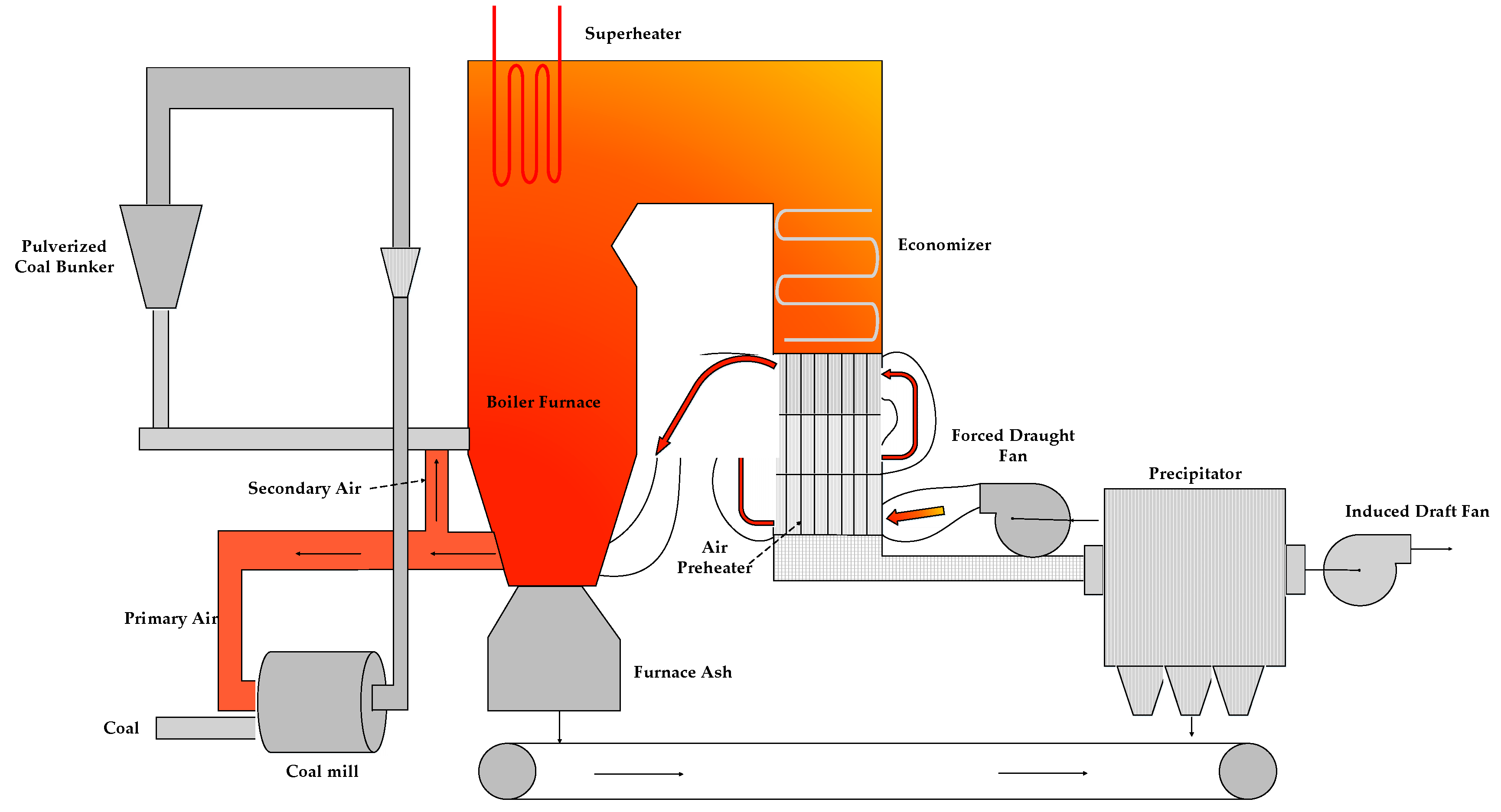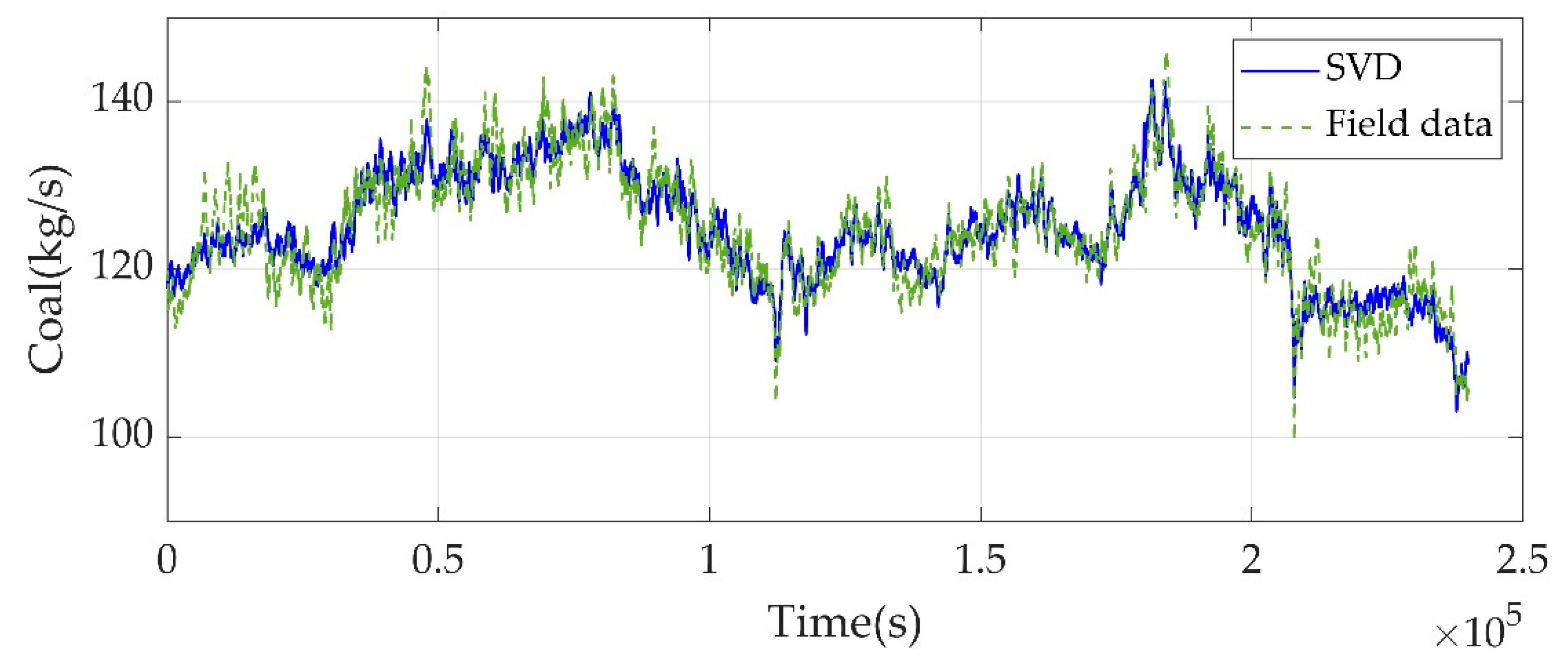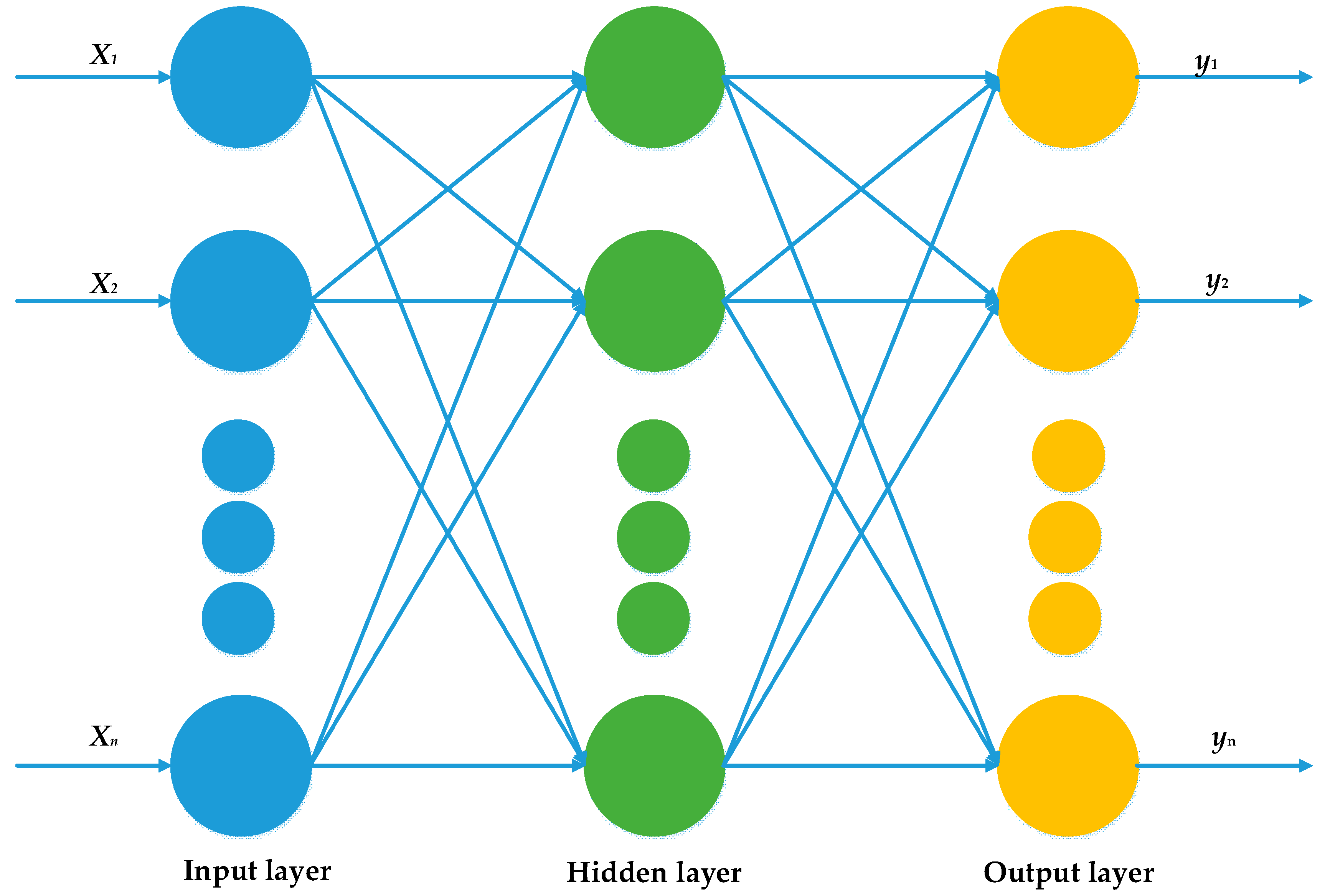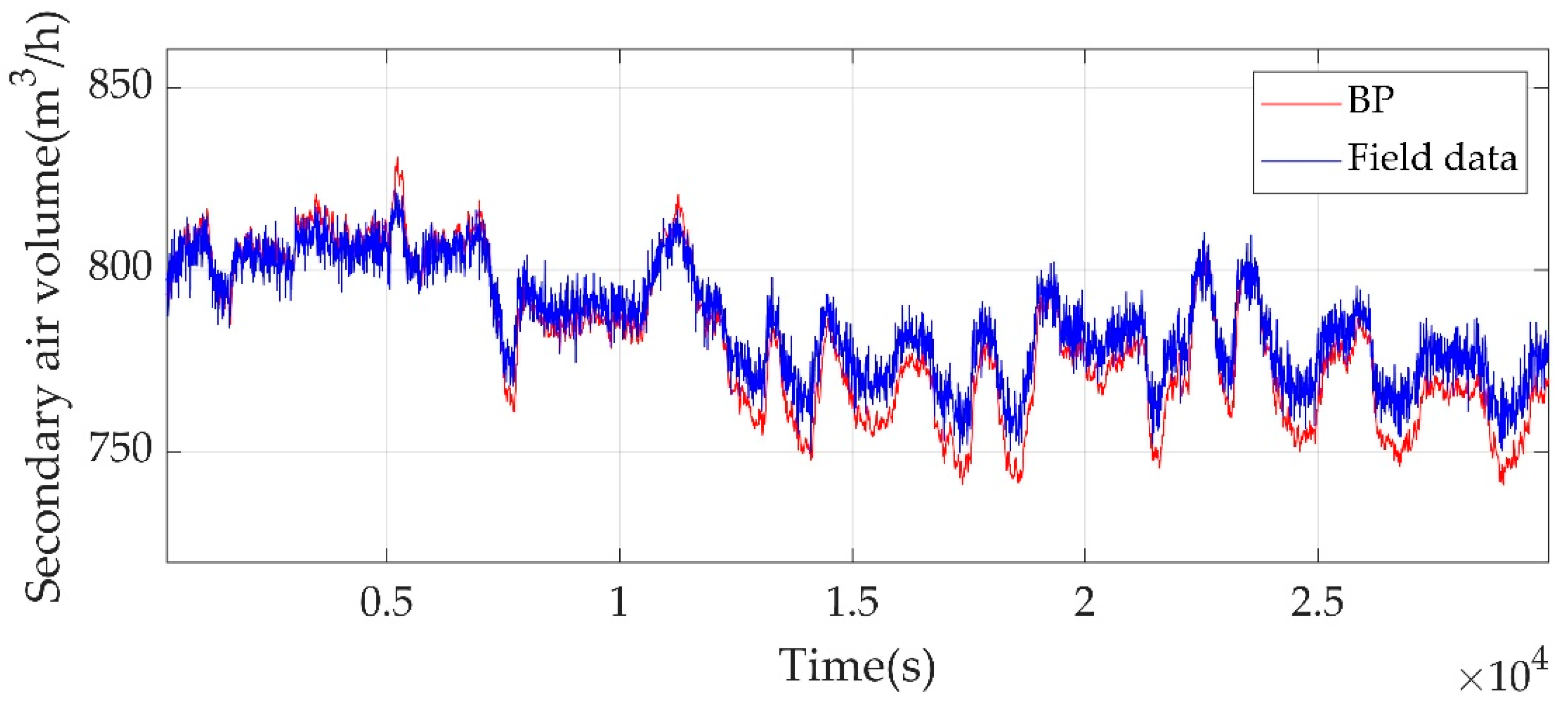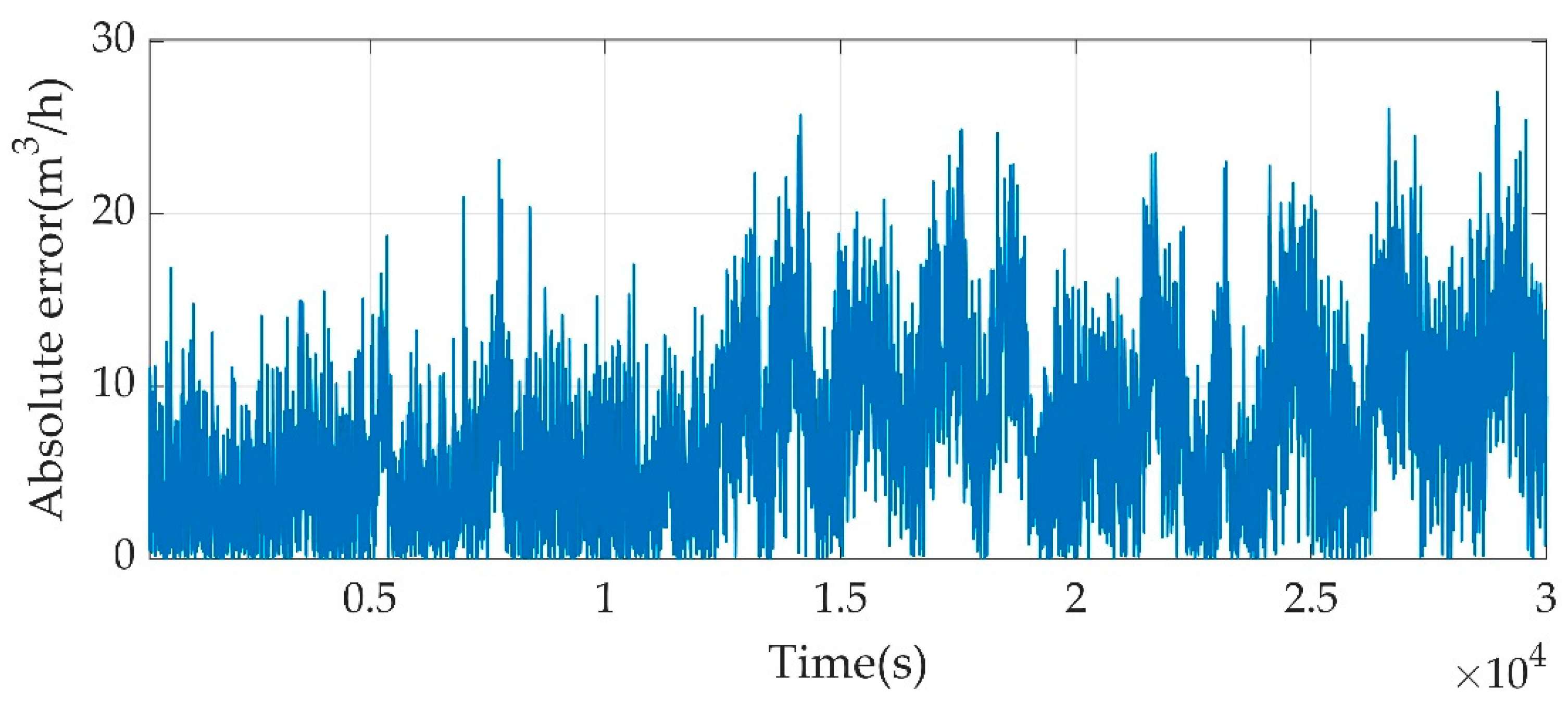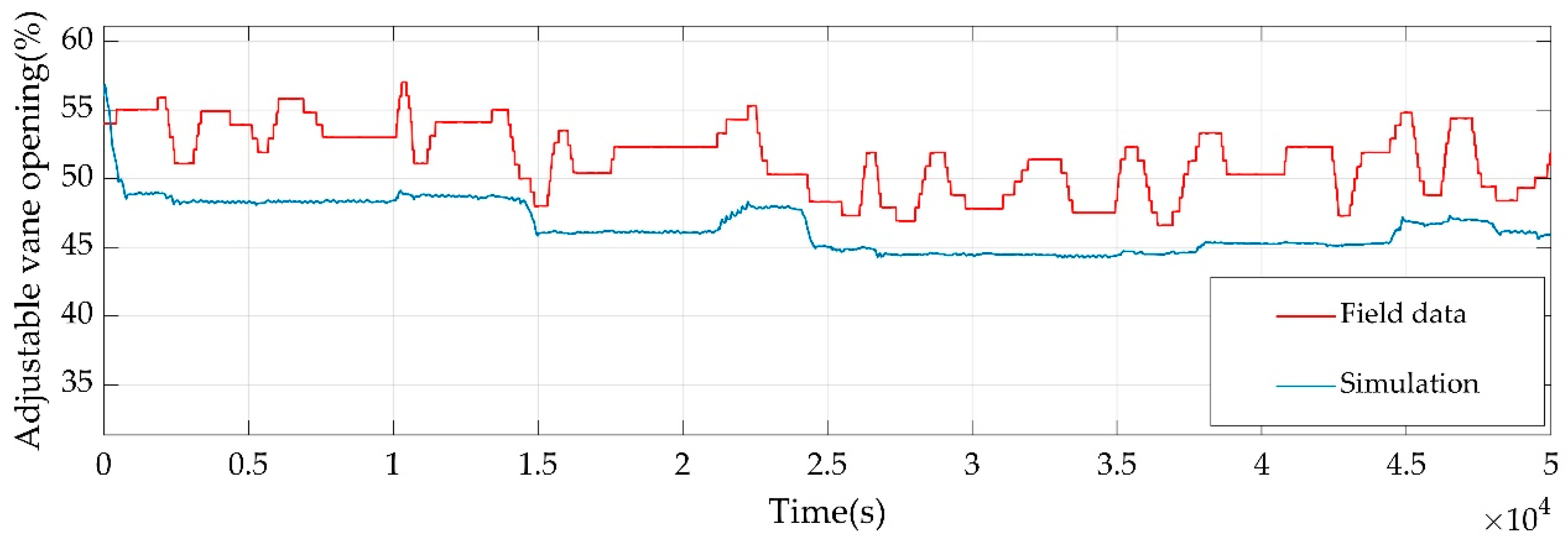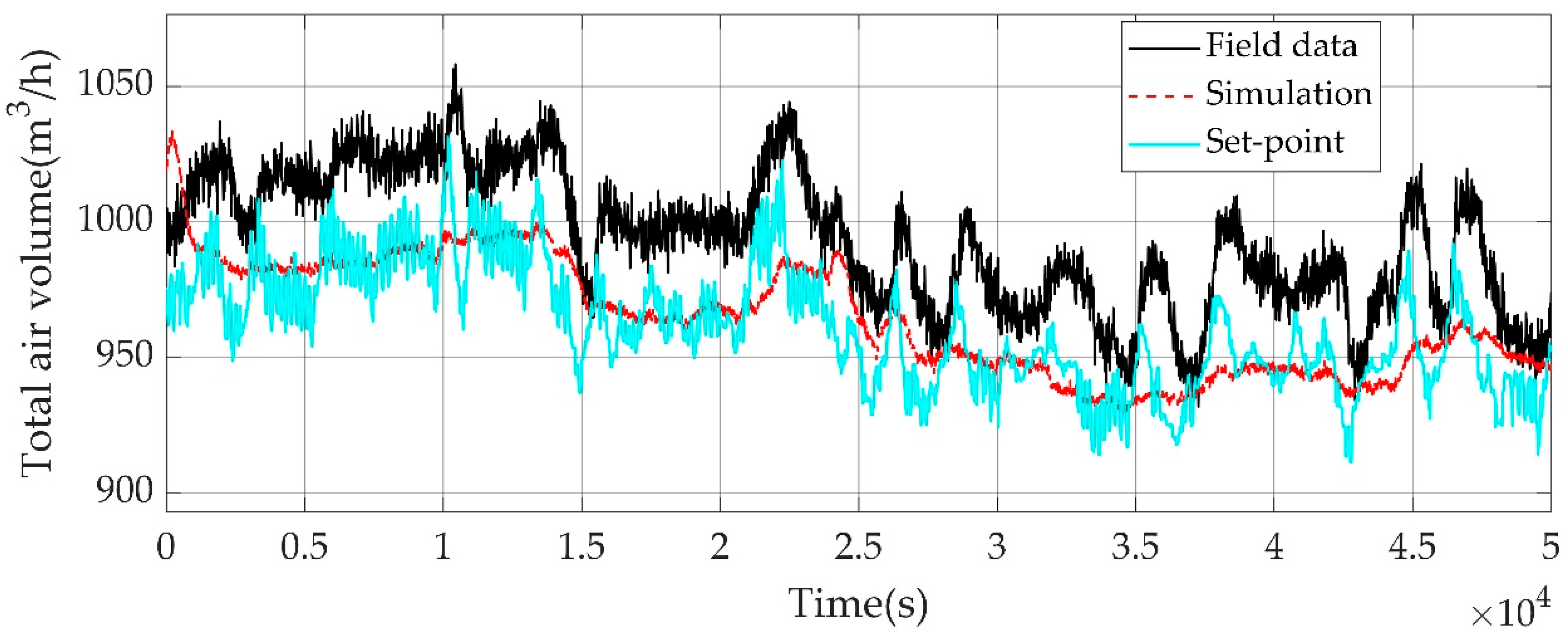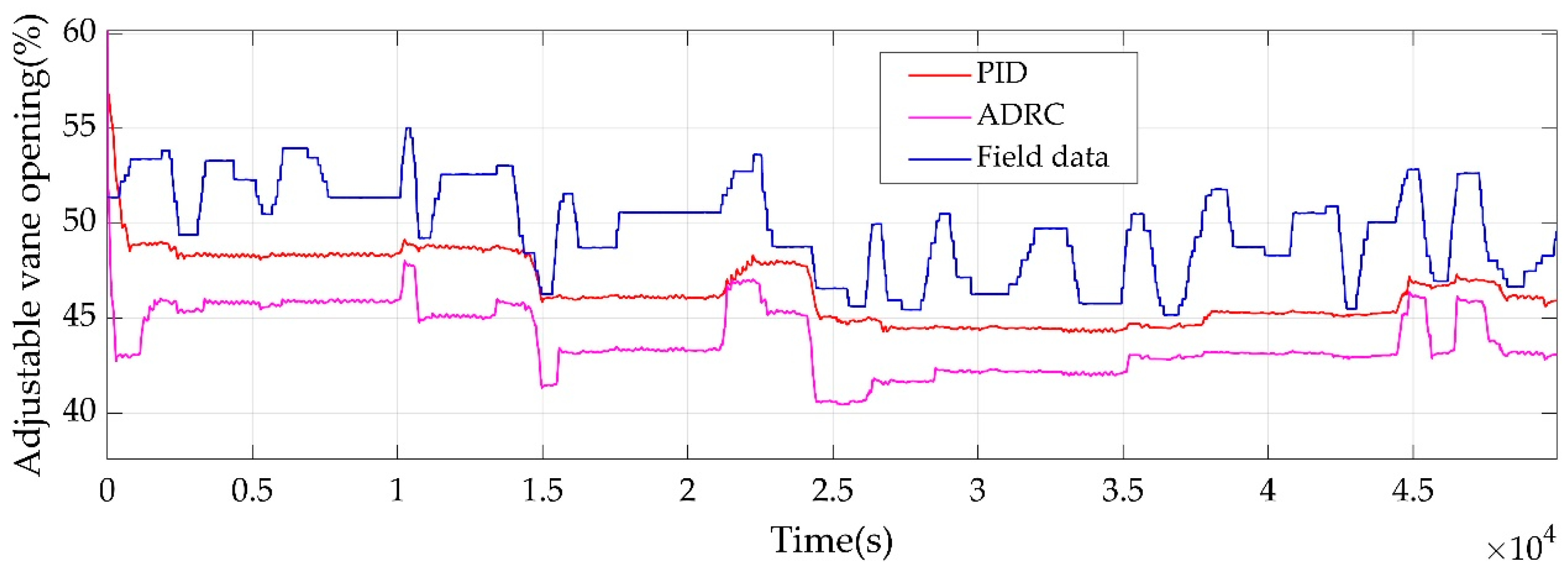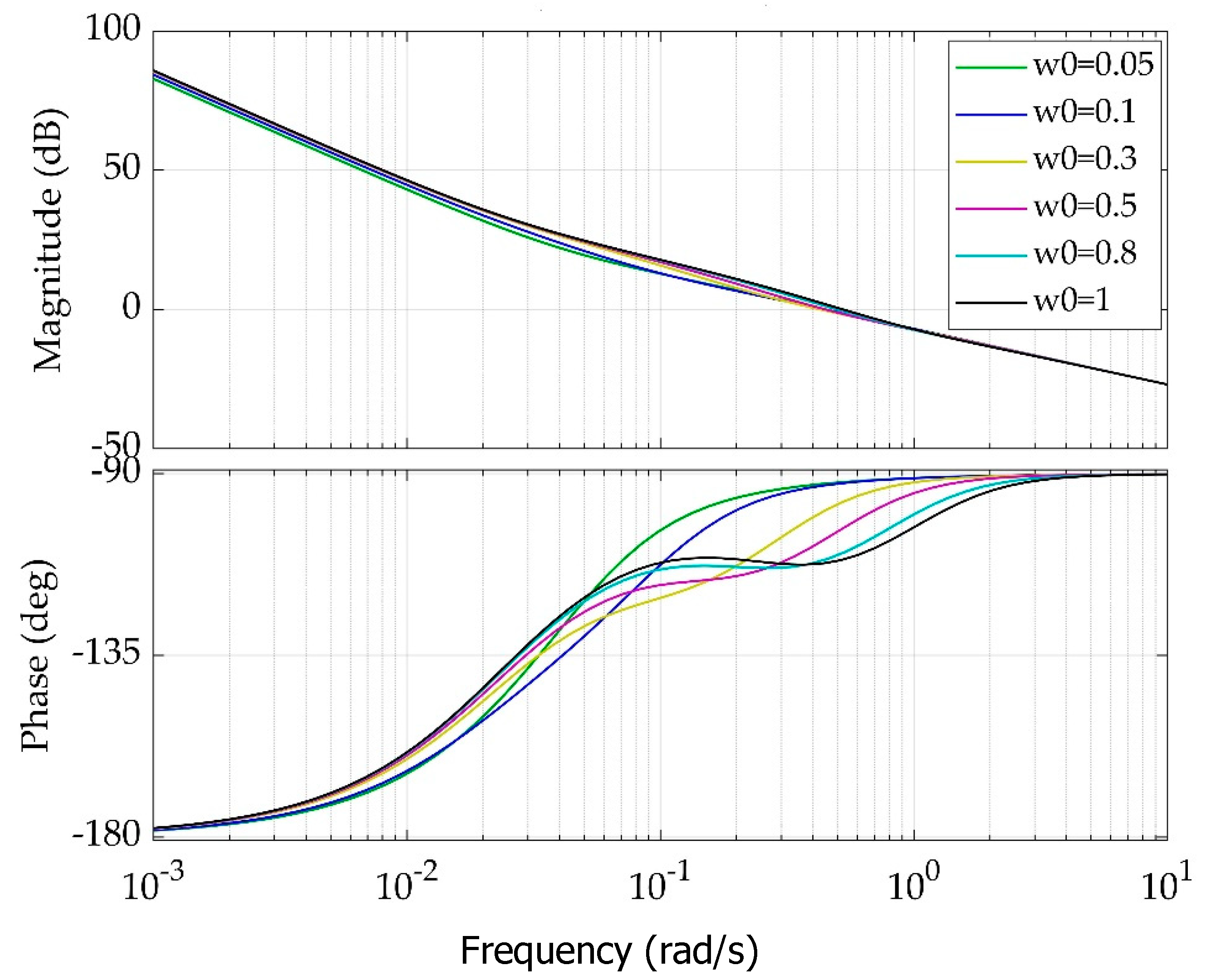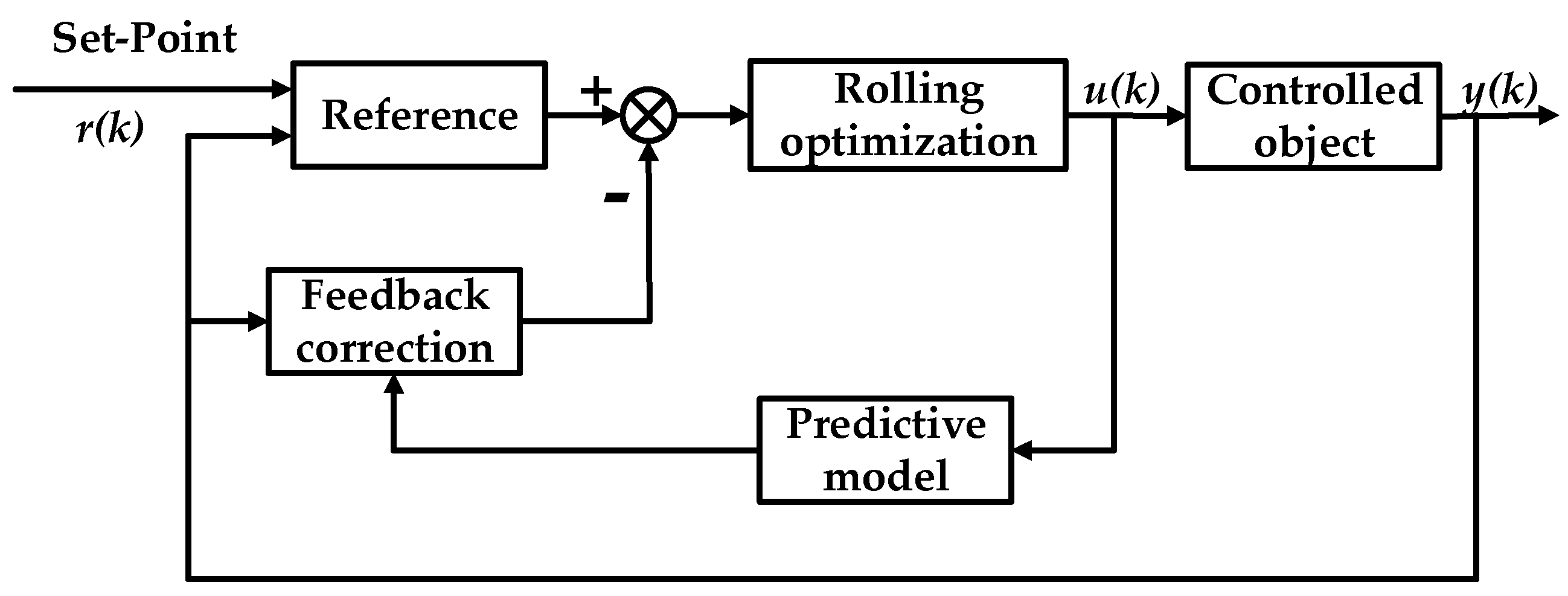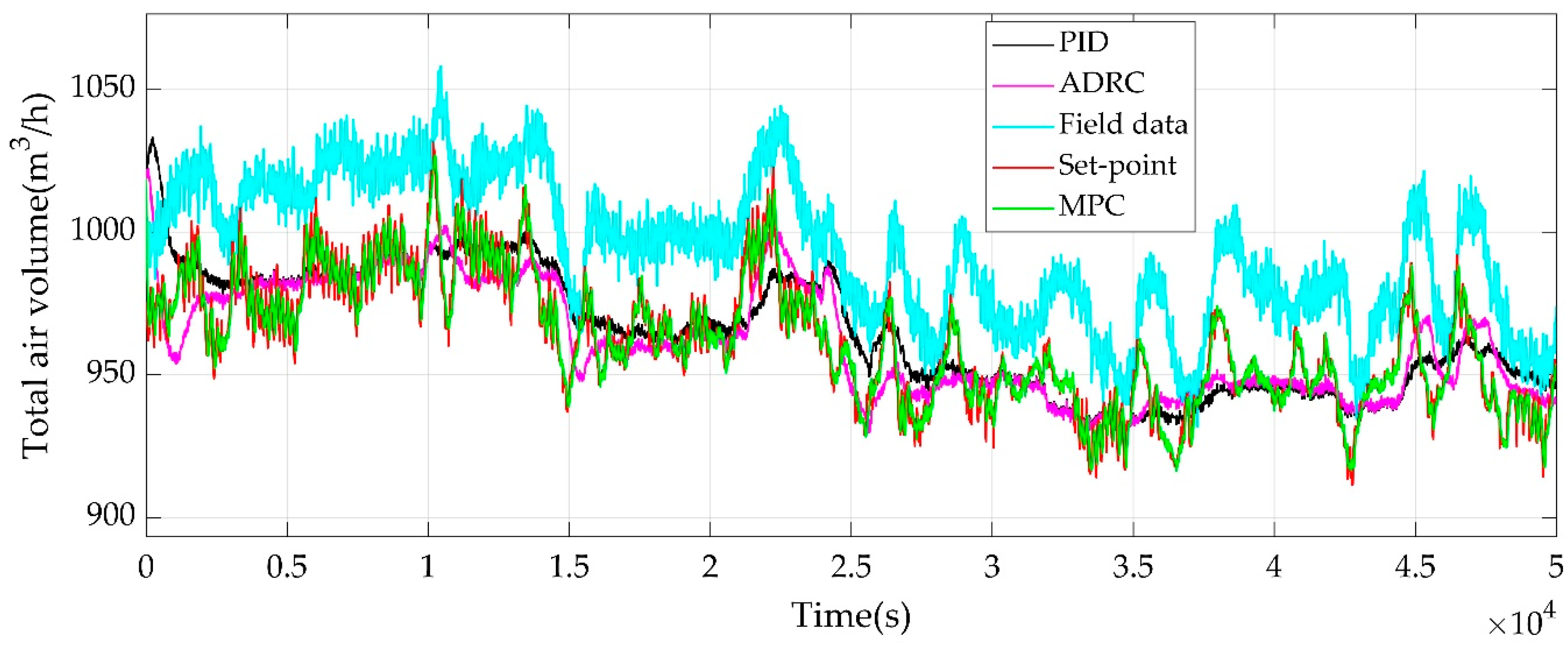1. Introduction
At present, China’s power generation is still dominated by thermal power. Thermal power generation accounts for most of the total power generation in China. The amount of coal consumed each year accounts for half of the total energy consumption of the country. However, the combustion of coal produces a lot of carbon dioxide and other harmful gases, bringing serious pollution to the environment [
1,
2]. By operating a boiler combustion system, which is one of the most important production equipment in the thermal power plant, economically and efficiently, we can greatly save the coal consumption and achieve energy saving and emission reduction by the thermal power plant. The boiler combustion control system mainly includes three subsystems: a forced draft control system, induced draft control system and fuel control system [
3]. The forced draft control system is mainly used to transport pulverized coal into the boiler and provide oxygen for boiler combustion. The induced air control system is mainly used to ensure the furnace negative pressure. The fuel control system is mainly used to change the amount of fuel entering the furnace according to the boiler instruction. Among them, the forced draft control system is in pursuit of the best air-coal ratio, (i.e., the air volume vs fuel injected into the boiler). In the best air-coal ratio state, the pulverized coal entering the furnace can be fully burned, leading to less emission of toxic gases like CO and heat loss in the production, which has great significance in energy conservation and emission reduction.
Combustion control is the most important aspect of boiler unit operation. The boiler combustion system is shown in
Figure 1. The coal is crushed by the coal mill and blown into the boiler by the primary air. After the coal is burned in the boiler, the flue gas passes through the superheater, reheater, economizer and air preheater for heat exchange. Finally, the flue gas is discharged into the atmosphere.
For large-scale coal-fired boiler, combustion air distribution is a main aspect of operation control. Different boiler equipment and coal quality have the optimal air distribution mode. The air distribution mode directly affects the economy of the boiler unit operation. If the air volume is too small or the fuel distribution is not appropriate, the flame center of the furnace will be low and the fuel combustion rate will be poor, leading to low steam temperature and boiler thermal efficiency. If the air volume is too large, it will cause the flame center of the furnace to move up and reduce the residence time of the pulverized coal in the combustion area of the furnace, leading to the increase of the desuperheating water volume and mechanical incomplete combustion loss [
3,
4,
5]. Therefore, unreasonable air distribution will affect the thermal efficiency of the boiler, the cycle efficiency of the unit and the economy of the unit operation.
For high-quality coal, if the primary air volume and secondary air volume are too low or the air distribution is not appropriate, it will cause early ignition and local reducing atmosphere in the furnace, resulting in burner damage and furnace slagging. For inferior coal and coal with low volatile content, excessive primary air volume will lead to boiler fire extinguishing and cause the combustion system to wear, affecting the stability and safety of the unit operation [
3,
4]. It can be seen that the rationality of boiler air distribution is the basis of unit operation economy and safety. With the higher requirements of automatic control for the units in operation, the automatic control of boiler combustion is a main content. The automatic control of combustion is basically achieved by the calculation of fuel quantity and air distribution volume and the correction of boiler oxygen content [
3]. Therefore, it is necessary to require the boiler unit to have a reasonable and accurate air volume control system. Only in this way can the boiler combustion be controlled deeply and accurately, and the unit operation can be guaranteed to have a higher level of safety, stability and economy.
In the actual power units, the air volume is often controlled by forced draft fans. The dynamic characteristics of the forced draft system are affected by other disturbances such as boiler load, coal supply, oxygen content in the furnace, etc. In the measurement of air volume, the existing measurement methods and equipment are limited by science and technology. Therefore, the air volume measurement is not accurate and the sampled data of air volume and coal quantity have more disturbances and noises, which makes identification very difficult. In order to improve the accuracy of identification model and establish a more accurate model of air supply system, it is necessary to reduce noise and classify the data. With the development of big data technology, de-noising methods and data classification methods have many new developments and are widely used. De-noising methods include three-sigma rule [
6], density-based spatial clustering of applications with noise (DBSCAN), singular value decomposition (SVD) [
7,
8,
9,
10] and so on. Data classification methods include k-means method, Gaussian mixture model method, k-nearest neighbor method [
6], back propagation (BP) neural network [
11,
12,
13,
14], etc. As a widely used data de-noising method, SVD is applied in many fields of engineering. A newly reported reweighted SVD method uses periodic modulation intensity criterion to measure how influential the periodic impulses are in each signal component [
7]. A novel SVD-based guided wave array signal processing approach is presented in [
8] for relatively weak signals. Based on singular value decomposition package (SVDP), an extended SVDP and its fast computation for extracting the resonance band excited by bearing defect with distinguished performance is proposed in [
9]. Online SVD for time-varying matrix is proposed in [
10]. At the same time, as an advanced modeling method, BP neural network also has been applied in many industrial or non-industrial models. An adaptive Kalman filtering algorithm based on BP neural network was proposed for real-time exhaled breath analysis in [
11]. In [
12], an improved genetic algorithm (GA)–simulated annealing algorithm (SA)–BP (GASA-BP) prediction model was established by introducing an adaptive learning rate into the original BP neural network algorithm for predicting coal and gas outburst. A BP neural network with principal component analysis method was used to forecast the bio aerosol concentration in [
13]. It presents in [
14] an improved method BP neural network back analysis of in-situ stress field, based on the calculated results of multivariate linear regression analysis. From the above literature, it can be seen that SVD can accurately extract data and has excellent performance in industrial data noise reduction. For big data, BP neural network modeling method can be used in a lot of aspects, and the prediction and analysis are more accurate. However, most of the current data-driven practices in power plant industry are macro fuel consumption prediction, fault data classification, etc. In data processing before modelling, data-driven practices is rare. This paper attempts to use the data of the boiler forced draft system to improve the accuracy of the model. Therefore in this paper, a data classification method of united SVD data de-noising method and advanced BP neural network is proposed to classify the data and improve the accuracy of closed-loop simulation, which is based on the massive data resources provided by the big data platform of a fossil power generation group. SVD can effectively reduce unnecessary noise in data. Meanwhile, after noise reduction, BP neural networks can also effectively learn the properties of training data to classify field data.
After classifying the data of air supply system, it is necessary to use the classified data to model forced draft control system. The forced draft control system is a single-input-single-output (SISO) system. The total air volume is controlled by the adjustable vane opening (AVO) of the forced draft fan, and associated with the coal quantity and the AVO of induced draft fan. For this system, the prediction error method (PEM) [
15,
16,
17,
18] is used in this paper for modeling using the classified data. As a mature modeling method, PEM has been verified on the reliability of modeling in various fields. In [
15], a stabilized version of PEM, where a virtual controller stabilizes the prediction error, was introduced. A novel approach for the task of speech reverberation suppression in non-stationary (changing) acoustic environments was proposed based on weighted prediction error method in [
16]. In [
17], a separable prediction error method for robot identification was proposed considering the physical parameters as well as the noise model. It presented in [
18] that a recursive prediction error method which can be applied on a model of any degree of complexity.
Based on the identified model and the actual proportional-integral-differential (PID) control strategy of the forced draft control system of a power plant in the city of Nanjing, Jiangsu Province, China, the closed-loop simulation system of forced draft control is established to verify the feasibility of the data classification method and the accuracy of the closed-loop identification model, and to study better control strategies. Since the forced draft control system is related to boiler combustion and coal supply, conventional PID control is difficult to overcome a lot of disturbances. When the load changes greatly, the conventional PID control cannot adapt to it as well as many other problems like large overshoot, long settling time and poor robustness, making it difficult to achieve satisfactory control effect. To solve these problems, some advanced control algorithms have been put forward such as active disturbance rejection control (ADRC) [
19,
20,
21,
22], model predictive control (MPC) [
23,
24,
25,
26], adaptive control and so on. Two robust control techniques estimating disturbances for small-scale unmanned helicopters: adaptive disturbance rejection control (ADRC) and disturbance observer based control (DOBC) are introduced and compared in [
19]. In [
20], ADRC was used in an open-cathode proton exchange membrane fuel cell (PEMFC), and extensive simulations demonstrated the uncertainty compensation ability of ADRC. It analyzed in [
21] that the control mechanism from the perspective of the modified plant, which, in turn, would give guidance to parameter tuning of ADRC and a complete tuning procedure for ADRC was developed. The capability of ADRC was investigated in [
22] in dealing with the nonlinear systems with multiple uncertainties and nonlinear measurement. As an advanced industrial control technology, MPC has been fully applied and developed. It considered in [
23] that distributed model predictive control (DMPC) for the vibrations of smart tensegrity structures with input saturation. In order to optimize the energy production of an inertial sea wave energy converter (ISWEC), an original model predictive control was used in [
24]. An adaptive model predictive control was developed in [
25] to solve parameter uncertainty of hybrid energy storage systems. A MPC approach was also used for hydrogen circulation system of polymer electrolyte membrane fuel cell in [
26]. Considering the strong disturbance-rejection ability of ADRC and good performance of MPC by using accurate identification model, they are studied in the forced draft control system respectively and compared with single PID control in this paper. Taking advantage of big data resource of power plants, this paper studies control strategy optimization on boiler forced draft system.
The purpose of the paper is to improve control performance of the boiler draft system in terms of fast command following which is critical for maintaining the best air-coal ratio. In pursuit of following the preset air-coal ratio tightly in operations of the combustion system, this paper proposed more effective modeling and control approaches on the boiler draft system. The main contributions of this paper are summarized as follows:
In order to establish an accurate model of the boiler forced draft system, a novel data classification method of united SVD data de-noising method and advanced BP neural network is proposed in this paper. This method can effectively reduce the noise, and reasonably screen the data for modelling.
The advanced ADRC controller is designed for the boiler forced draft system and applied to the model. The stability of the ADRC control loop for boiler forced draft systems is analyzed in the frequency domain and its flexible stability margin is shown.
The good control performance of ADRC is proved by comparing with other control approaches including single MPC and PID and is also evaluated by comparing with the field data from the real control system.
The rest of the paper is organized as follows. In
Section 2, the data classification method called SVD-BP is introduced for extracting identification data. In
Section 3, the simulation system of boiler forced draft control is established for verifying closed-loop identification accuracy and for control study. In
Section 4, the advanced control strategies of boiler forced draft control system are studied based on the closed-loop simulation system and compared with each other. Conclusions are drawn in
Section 5.
2. Data Preprocessing
Because of the dynamic characteristics of the forced draft control system, the error of the air volume measurement strategy and equipment, and other unknown disturbance problems, the data of air volume and coal volume has great volatility. In order to establish an accurate model of the forced draft control system, it is necessary to reduce noise and classify the data. This paper performs noise reduction and classification based on field data from a big-data platform on a boiler forced draft control system in a power plant. First, the dynamic characteristics of the forced draft control system and the characteristics of data are analyzed. Second, SVD is used for filtering noisy data. Third, the BP neural network is used for the de-noised data to find the best identification data segment.
2.1. The Dynamic Characteristics of the Forced Draft Control System
In the forced draft control system, the air enters the boiler through the primary fan and the secondary fan. Before the air enters the boiler, it is heated by an air preheater to improve the boiler thermal efficiency. The role of primary air is to transport and dry pulverized coal, and to supply the air required for fuel combustion. The main process of primary air is that the air enters the primary fan the air preheater. After being heated by the air preheater, the air enters the coal mill. At the proper temperature and flow rate, the pulverized coal is dried by the primary air and transported through the pulverized coal pipeline to the burner nozzle to be injected into the furnace for combustion. The role of secondary air is to supply the oxygen required for fuel combustion. The secondary air directly enters the boiler after passing through the air preheater. The process flow diagram of the forced draft system is shown in
Figure 2, and the conventional control strategy of the forced draft system is shown in
Figure 3.
Because the primary air flow depends on the primary air volume required by the combustion system and the amount of air leakage through the air preheater, we only need to control the secondary air volume to achieve the purpose of controlling the total air volume. Simultaneously, the set-point of the total air volume is calculated based on the oxygen content of the flue gas. It can be seen from
Figure 2 that the total air volume is determined by the amount of coal, the AVO of the forced fan and the induced fan. Thus the inputs of the model can be chosen as the AVOs of the forced fan, the induced fan A, B and the amount of coal, denoted as
u1,
u2,
u3 and
u4 in
Figure 3. The output of the model is the total air volume, denoted as
y in
Figure 3. The corresponding field data is shown in
Figure 4.
It follows from
Figure 4a,b that the data of air volume and coal volume exhibits obvious volatility, whose noise needs to be reduced. In contrast, the AVOs of forced fan and induced fan have less fluctuation and noise.
2.2. Noise Reduction Based on SVD
The SVD problem of time-varying matrix can be expressed as the following formula, in general.
Thereinto, A(t) is a m × n matrix; U(t) and V(t) are m × n and n × n unitary matrices; is a m × n time-varying diagonal matrix. Simply speaking, the SVD of A(t) is a factorization of the form .
Considering the field data is in the real number field, we only discuss SVD in the real number field in this paper. Assume
being a smoothly time-varying matrix, and consider the following equation system:
where
and
are
and
matrices; orthogonal matrices
and
, and diagonal matrix
are the unknown matrices to be solved. Evidently, Equation (2) is equivalent to the time-varying SVD problem (1).
According to the filed data we get,
can be composed of secondary air volume and coal volume.
is a matrix of 250,000 × 2. Then, 95% of the sum of diagonal elements of
is chosen to form a new
. At last, a new matrix
as the new secondary air volume and coal volume after noise reduction is recombined.
is a factorization of the form
. The corresponding sub-matrixes
and
are extracted from
and
, according to the length of the rows and columns of
. Through SVD de-noising, the secondary air volume and coal are shown in
Figure 5 and
Figure 6.
As can be seen in
Figure 5 and
Figure 6, the noise in the total coal are obviously reduced. At the same time, the noise of secondary air volume is reduced by a certain amount. The obvious outliers have been removed.
2.3. BP Neural Network Screening Method
A BP neural network generally consists of an input layer, an output layer and a hidden layer connected by a group of weight factors. The basic architecture of BP neural network is shown in
Figure 7.
According to the forward operation of input data, BP neural network calculates the final network error and transmits the error in the opposite direction. Based on the error, the weights can be adjusted under certain rules. After being trained with a large number of data samples, the neural network model can approach any nonlinear model.
Before training the neural network, normalization was necessary. Normalization can avoid some unnecessary numerical problems and unify evaluation standard. Normalization is also good for gradient descent algorithm, making the network converge quickly. The normalization used in this paper is shown in Equation (3a). The x is the input of the neural network. At the same time, the activation function of the neural network is the rectified linear unit shown in Equation (3b). The x is the output of the hidden layer.
The input layer of the model are the AVOs of the forced fan and the induced fan A, B, and the amount of coal. The output layer of the model is the total air volume.
After normalization, the training samples and testing samples need to be prepared well. In this paper, 7800 groups of data from one day were labeled as accurate data and 80% of the data constitutes the training set. The rest constituted the validation set. A total of 250,000 groups of data another day constituted a testing set. The sampling time was 1 s.
Then the neural network is trained by training set. As a fully interconnected network, there are four neurons in the input layer, one neuron in the output layer, and 15 neurons in the hidden layer, respectively. The biases are random numbers.
The trained model is validated by validation set and tested by testing set. The fit of the validation set reached 80%. The test results are shown in the following
Figure 8 and
Figure 9.
As can be seen, the absolute error between field data and calculated data is 20. We assumed that if the absolute error is within 5, the current value can be used for identification. At every 1000 points, we calculate the number of the identifiable data in the data length of 10,000. The data segment with the most identifiable data is the optimal identification data segment. A segment starting from 123,000 to 133,000 is the optimal segment.
